Testing out your green thumb this year? Here are a few tips for starting a vegetable garden.

Second, consider what produce you and your family prefer. If your family enjoys tomatoes, perhaps plant colorful heirloom varieties along with your standard grape and Roma types. Or if everyone’s favorite recipes include fresh basil, chives or rosemary, why not grow your own just a few steps from the kitchen?

Heirloom tomatoes offer a unique variety of colors, textures, sizes, and flavors from species to species.
Of course, a garden isn’t complete without adding flowers into the mix. Flowers add not only a pop of color but they also attract pollinators, such as bees, which can improve your garden’s yield. Try annual flowers such as zinnia, African marigold, nasturtium, and sunflower, which are easy to purchase as small potted plants or to grow from seeds.
If you plan on growing your produce from seeds, there are plenty of free and biodegradable options for starting pots. Many of these DIY options can be planted directly into the ground. Options include:
- Homemade paper pots
- Toilet paper tubes
- Egg cartons
- Eggshells
- Avocado skins or citrus halves

You don’t need fancy pots from the store to get your seedlings off to a good start.
Not interested in keeping up with a vegetable garden? Try planting vegetation native to your area, which is typically low-maintenance and minimal care. Check out our Florida Gardening article for more information.